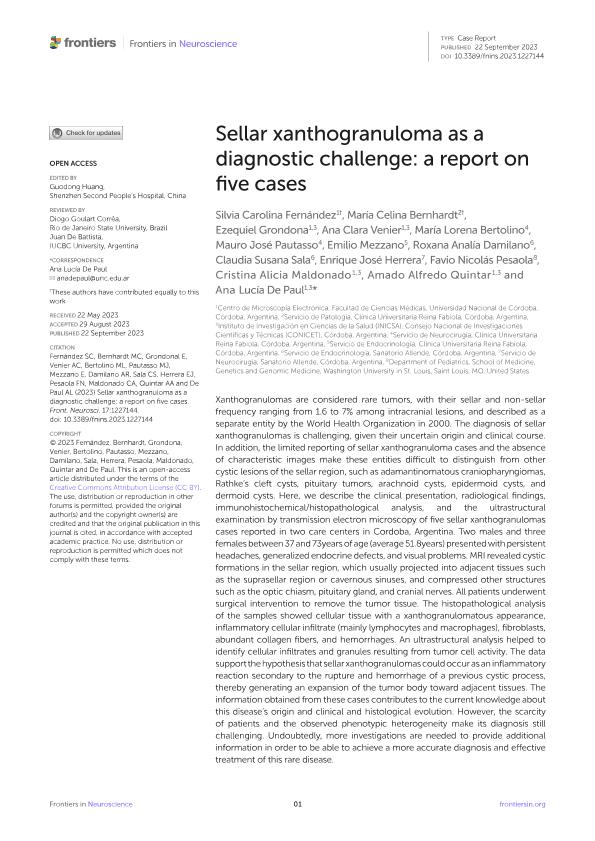Artículo
Sellar xanthogranuloma as a diagnostic challenge: A report on five cases
Fernandez, Silvia Carolina; Bernhardt, María Celina; Grondona, Ezequiel ; Venier, Ana Clara
; Venier, Ana Clara ; Bertolino, María Lorena; Pautasso, Mauro José; Mezzano, Emilio; Damilano, Roxana Analía; Sala, Claudia Susana; Herrera, Enrique José; Pesaola, Favio Nicolás; Maldonado, Cristina Alicia
; Bertolino, María Lorena; Pautasso, Mauro José; Mezzano, Emilio; Damilano, Roxana Analía; Sala, Claudia Susana; Herrera, Enrique José; Pesaola, Favio Nicolás; Maldonado, Cristina Alicia ; Quintar, Amado Alfredo
; Quintar, Amado Alfredo ; de Paul, Ana Lucia
; de Paul, Ana Lucia
 ; Venier, Ana Clara
; Venier, Ana Clara ; Bertolino, María Lorena; Pautasso, Mauro José; Mezzano, Emilio; Damilano, Roxana Analía; Sala, Claudia Susana; Herrera, Enrique José; Pesaola, Favio Nicolás; Maldonado, Cristina Alicia
; Bertolino, María Lorena; Pautasso, Mauro José; Mezzano, Emilio; Damilano, Roxana Analía; Sala, Claudia Susana; Herrera, Enrique José; Pesaola, Favio Nicolás; Maldonado, Cristina Alicia ; Quintar, Amado Alfredo
; Quintar, Amado Alfredo ; de Paul, Ana Lucia
; de Paul, Ana Lucia
Fecha de publicación:
09/2023
Editorial:
Frontiers Media
Revista:
Frontiers in Neuroscience
e-ISSN:
1662-453X
Idioma:
Inglés
Tipo de recurso:
Artículo publicado
Clasificación temática:
Resumen
Xanthogranulomas are considered rare tumors, with their sellar and non-sellar frequency ranging from 1.6 to 7% among intracranial lesions, and described as a separate entity by the World Health Organization in 2000. The diagnosis of sellar xanthogranulomas is challenging, given their uncertain origin and clinical course. In addition, the limited reporting of sellar xanthogranuloma cases and the absence of characteristic images make these entities difficult to distinguish from other cystic lesions of the sellar region, such as adamantinomatous craniopharyngiomas, Rathke’s cleft cysts, pituitary tumors, arachnoid cysts, epidermoid cysts, and dermoid cysts. Here, we describe the clinical presentation, radiological findings, immunohistochemical/histopathological analysis, and the ultrastructural examination by transmission electron microscopy of five sellar xanthogranulomas cases reported in two care centers in Cordoba, Argentina. Two males and three females between 37 and 73 years of age (average 51.8 years) presented with persistent headaches, generalized endocrine defects, and visual problems. MRI revealed cystic formations in the sellar region, which usually projected into adjacent tissues such as the suprasellar region or cavernous sinuses, and compressed other structures such as the optic chiasm, pituitary gland, and cranial nerves. All patients underwent surgical intervention to remove the tumor tissue. The histopathological analysis of the samples showed cellular tissue with a xanthogranulomatous appearance, inflammatory cellular infiltrate (mainly lymphocytes and macrophages), fibroblasts, abundant collagen fibers, and hemorrhages. An ultrastructural analysis helped to identify cellular infiltrates and granules resulting from tumor cell activity. The data support the hypothesis that sellar xanthogranulomas could occur as an inflammatory reaction secondary to the rupture and hemorrhage of a previous cystic process, thereby generating an expansion of the tumor body toward adjacent tissues. The information obtained from these cases contributes to the current knowledge about this disease’s origin and clinical and histological evolution. However, the scarcity of patients and the observed phenotypic heterogeneity make its diagnosis still challenging. Undoubtedly, more investigations are needed to provide additional information in order to be able to achieve a more accurate diagnosis and effective treatment of this rare disease.
Archivos asociados
Licencia
Identificadores
Colecciones
Articulos(INICSA)
Articulos de INSTITUTO DE INVESTIGACIONES EN CIENCIAS DE LA SALUD
Articulos de INSTITUTO DE INVESTIGACIONES EN CIENCIAS DE LA SALUD
Citación
Fernandez, Silvia Carolina; Bernhardt, María Celina; Grondona, Ezequiel; Venier, Ana Clara; Bertolino, María Lorena; et al.; Sellar xanthogranuloma as a diagnostic challenge: A report on five cases; Frontiers Media; Frontiers in Neuroscience; 17; 1227144; 9-2023; 1-10
Compartir
Altmétricas



